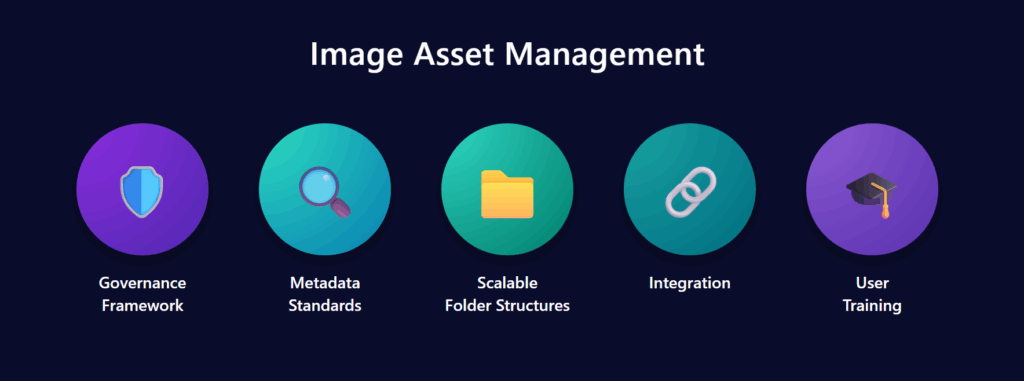Modern organizations need sophisticated image management systems to stay competitive in 2025.
- AI automation reduces manual tagging time while improving searchability.
- Industry-specific workflows ensure compliance in regulated sectors like CPG and life sciences.
- Centralized platforms eliminate scattered assets and reduce content recreation costs.
- Performance analytics provide measurable ROI from visual content investments.
Smart image management is essential for brands that want to scale efficiently while maintaining quality and compliance.
You’ve probably heard the saying “a picture is worth a thousand words”—and in marketing, that couldn’t be more true. Visual content doesn’t just catch the eye; it sticks in people’s minds. When you pair images with text, information retention jumps from a measly 10% to an impressive 65%. That’s the difference between someone scrolling past your content and actually remembering it.
But here’s the challenge—managing all those images can quickly become overwhelming. Marketing teams and content managers face a familiar struggle: spending countless hours trying to keep visual assets organized and accessible.
Fortunately, technology has stepped up to help solve the challenge of managing brand images more effectively.
What is Image Management?
Image management allows companies to efficiently catalog, organize, share, and store digital images. It involves creating and managing a database of collected images and tasks, such as optimizing image files for different image sizes across platforms, cropping them to specific sizes, attaching relevant information like captions and keywords for easy searching, and backing up those images for safekeeping.
A Digital Asset Management platform (DAM) is designed specifically for organizing, storing, cataloging, and retrieving digital media files. Effective digital image management creates searchable, secure, and scalable systems that enable teams to find, use, and repurpose visual content efficiently. When properly implemented, these systems become strategic assets that accelerate content creation while ensuring brand consistency and regulatory compliance.
How Does Image Management Benefit Your Organization?
Smart image asset management practices improve every stage of the content lifecycle.

Operational Efficiency and Time Savings: Centralizing images into a DAM system ensures teams always have access to every asset. A dynamic DAM system puts every asset at your fingertips and enables efficient reuse and data management without the need to manage each asset individually.
Brand Consistency and Quality Control: Centralized systems ensure teams access current, approved assets rather than outdated versions hiding in personal folders. Version control features prevent embarrassing brand inconsistencies while maintaining visual quality standards across all channels and touchpoints.
Cost Reduction Through Asset Reuse: Organizations with effective image management report a reduction in duplicate asset creation. Instead of commissioning new photography or graphics, teams can quickly locate and repurpose existing high-quality content, delivering significant cost savings over time.
Scalable Growth Support: As organizations grow into new markets or launch additional product lines, structured image management grows right along with them. Automated tagging, intelligent categorization, and flexible taxonomies accommodate growth without proportional increases in management overhead.
What Are the Essential Components of Effective Image Management?
Successful DAM systems combine several critical elements that work together to create comprehensive solutions:
Centralized Storage and Organization: All visual assets reside in a single, searchable repository with logical folder structures and consistent naming conventions. Centralization eliminates data silos while providing universal access to approved content across teams and departments.
Intelligent Metadata and Tagging Systems: A powerful DAM is a discovery engine for every type of asset. Rich metadata enables precise searches and automated categorization. Today’s systems use AI to automatically generate descriptive tags, identify objects within images, and create searchable text from visual content.
Access Controls and Security Features: DAM is an important aspect of risk management, creating a source of truth for all images, past and present. Granular permissions ensure appropriate access while protecting sensitive content. Features include user role management, download tracking, watermarking capabilities, and secure sharing options for external collaborators.
Integration and Workflow Automation: Centralizing images allows the DAM system to automate certain aspects of the content creation and management process. Seamless connections with existing tools accelerate workflows and reduce manual tasks. Benefits stem from integrations with creative software, content management systems, social media platforms, and marketing automation tools.
Distribution and Archiving: A DAM for images can deliver compliant assets to end users through a brand portal or CMS. The platform also ensures that changes made within the asset library are automatically pushed to relevant outside systems and users. A good image management solution also creates a historical record of past assets and campaigns.
Performance Analytics and Reporting: DAMs that integrate with other vital marketing systems allow you to add more context to every asset over time. Comprehensive analytics track asset usage, measure content performance, and identify optimization opportunities. These insights inform future content strategies while demonstrating ROI from image management investments.
How Do Industry-Specific Image Workflows Address Unique Challenges?
Every industry faces distinct image management challenges. What works for a tech startup won’t meet the complex requirements of a pharmaceutical company navigating FDA regulations.
Consumer Packaged Goods (CPG) Image Requirements
CPG companies manage complex product imagery across multiple markets, channels, and regulatory environments. Their image workflows must accommodate:
Product Lifecycle Management: Images move through development, testing, launch, and retirement phases with specific approval requirements at each stage. Version control becomes vital when managing packaging updates, seasonal variations, and market-specific adaptations.
Multi-Channel Consistency: The same product images need optimization for e-commerce platforms, print catalogs, social media, and point-of-sale materials. Automated cropping and resizing capabilities ensure consistent presentation across all touchpoints.
Regulatory Compliance: Different markets require specific claims, ingredient lists, and warning labels. Image asset systems must track which assets are approved for specific regions while maintaining audit trails for regulatory reviews.
Life Sciences Image Governance
Life sciences organizations face stringent regulatory requirements that make image management particularly critical for compliance and operational efficiency:
MLR (Medical, Legal, Regulatory) Approval Workflows: All patient-facing materials require multi-stage approvals with detailed documentation. Automated workflow routing ensures proper review sequences while maintaining comprehensive audit trails for regulatory submissions.
Intellectual Property Protection: Research images, clinical data visualizations, and proprietary methodologies need secure storage with controlled access. Digital rights management features protect sensitive content while enabling necessary collaboration.
Cross-Functional Collaboration: Research teams, marketing departments, and regulatory affairs must share visual content while maintaining version control and approval status transparency. Centralized systems prevent the use of outdated or non-approved materials.
How Does AI Change the Game for Image Management?
Generative AI tools have made it easier to create image assets quickly. At the same time, these technologies make the need for DAM all the more pressing. Creating, verifying, and controlling AI-created assets will become a new requirement for DAM librarians and brand managers.

DAM will help teams manage this influx of images and related content more effectively:
- Automated Tagging and Categorization: AI algorithms analyze visual content to automatically generate descriptive metadata. These systems identify objects, people, settings, colors, and concepts within images, creating rich tagging that improves searchability. Machine learning models continuously improve accuracy based on user interactions and feedback.
- Smart Cropping and Optimization: Intelligent cropping algorithms identify focal points and important elements within images, automatically generating crops optimized for different platforms and formats. This process eliminates manual work while ensuring visual impact across various aspect ratios and display sizes.
- Content Intelligence and Gap Analysis: Advanced analytics identify content gaps and optimization opportunities by analyzing usage patterns, performance data, and market trends. These insights guide content strategy decisions while maximizing the value of existing image libraries.
- Predictive Metadata and Asset Recommendations: AI systems suggest relevant assets based on project context, past usage patterns, and content performance data. This accelerates content selection while improving the likelihood of choosing high-performing visuals for specific campaigns or contexts.
Artificial intelligence capabilities are revolutionizing how organizations handle visual content, with AI-powered solutions becoming standard rather than optional.
5 Best Practices for Image Asset Management
Making the most of your time and your asset libraries is easier when you create repeatable best practices and policies for your organization. When crafting your policies and content governance, consider these best practices:

1. Establish a Clear Governance Framework: Define roles, responsibilities, and processes before implementing technology solutions. Consider naming conventions, approval workflows, archival policies, and access controls that align with organizational structure and compliance requirements.
2. Implement Comprehensive Metadata Standards: Develop consistent metadata schemas that support both current needs and future growth. Include descriptive tags, usage rights information, performance data, and contextual details that enable effective searching and automated workflows.
3. Create Scalable Folder Structures: Design logical hierarchies that accommodate business growth and evolution. Consider organizing by campaign, product line, content type, or lifecycle stage based on how teams naturally seek and use visual content.
4. Enable Integration Capabilities: Connect image management systems with existing tools and workflows to minimize disruption and maximize adoption. Integration includes creative software, marketing platforms, content management systems, and business applications that consume visual content.
5. Plan for User Training and Change Management: Invest in comprehensive training programs that help teams understand both technical capabilities and business benefits. Ongoing education ensures maximum value realization as systems evolve and expand.
Image Asset Management Implementation Checklist
Use this comprehensive checklist to guide your image management strategy:
Foundation Setup
- Audit existing image assets and identify scattered repositories
- Define metadata standards and naming conventions
- Establish user roles and access permissions
- Create folder structures aligned with business workflows
Technical Implementation
- Configure automated backup and disaster recovery procedures
- Set up integration connections with existing business tools
- Implement security controls and compliance features
- Test upload, search, and distribution capabilities
Governance and Training
- Document approval workflows and responsibility assignments
- Train team members on system capabilities and best practices
- Establish performance metrics and success measurements
- Create ongoing maintenance and optimization procedures
Optimization and Growth
- Monitor usage patterns and user feedback regularly
- Implement AI-powered features for automation opportunities
- Expand integration capabilities based on business needs
- Scale storage and user access as the organization grows
How Do Leading Organizations Measure Image Management Success?
Effective measurement demonstrates value while identifying optimization opportunities. Key performance indicators include:
Efficiency Metrics: Time savings in asset location, reduced duplicate content creation, and faster campaign launches provide quantifiable efficiency improvements.
Cost Reduction Measurements: Calculate savings from increased asset reuse, reduced storage costs, and eliminated redundant licensing fees.
Quality and Compliance Indicators: Track brand consistency scores, compliance violation reductions, and approval process cycle times.
User Adoption and Satisfaction: Monitor system usage rates, user feedback scores, and training completion metrics to ensure successful implementation.
Organizations that implement comprehensive image asset management solutions report significant improvements across these metrics, with many achieving ROI within the first year of implementation.
Frequently Asked Questions
How does AI enhance digital image management? AI automates manual tasks like tagging, cropping, and categorization, making images easier to find and use. A DAM for images can analyze visual content, generate predictive metadata, and optimize images for different platforms, dramatically reducing time-to-market.
What makes image asset management different from cloud storage? Basic storage only houses files. Image asset management goes further by layering governance, intelligent search, performance analytics, and integrations with creative and marketing tools. A DAM becomes a strategic system of record that actively supports campaigns and compliance.
How can digital image management reduce costs? By centralizing assets, teams avoid recreating images they already own. Organizations using DAM for images report fewer duplicates, lower licensing fees, and higher reuse of existing visuals, all contributing to measurable ROI.
Why is governance critical in image asset management? Regulated industries like life sciences and financial services require strict oversight. A DAM provides version control, audit trails, and digital rights management to ensure every image is compliant, secure, and ready for use.
How do I know if my business needs a DAM for images? If teams spend more time searching for files than creating campaigns, or if brand inconsistencies slip into the market, it’s time. A modern DAM platform consolidates scattered repositories, safeguards compliance, and scales digital image management as your business grows.
Automate Image Management with Aprimo
Modern image asset management is essential for organizations that depend on visual content to drive business results. The combination of centralized storage, intelligent automation, and industry-specific workflows creates competitive advantages while reducing costs and risks.Aprimo delivers comprehensive image management capabilities that transform how organizations create, manage, and distribute visual content. Our AI-powered platform combines intelligent automation with industry-specific workflows to help teams achieve their content operations goals efficiently and effectively. Start a free trial of Aprimo DAM today.


